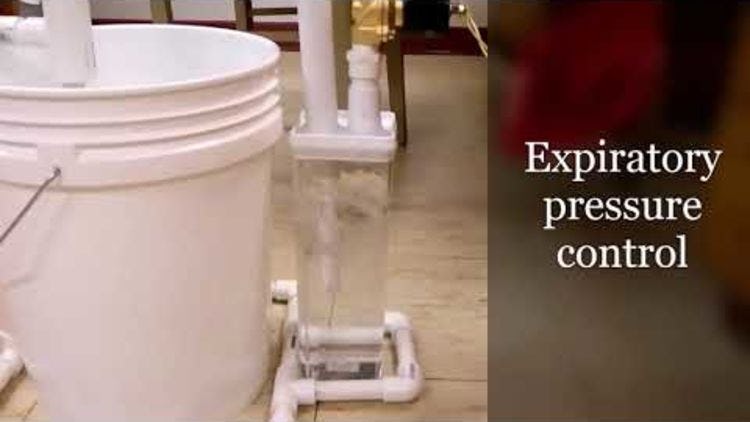Novel Injection Therapy, Ventilators May Aid Treatment of COVID-19, Respiratory Distress
$50 ventilators can be fabricated from common, inexpensive materials
Patients infected with COVID-19 often develop severe breathing symptoms as their illnesses worsen; this condition, known as acute respiratory distress syndrome (ARDS), also occurs due to a range of other causes. Those in critical condition with ARDS must be treated by mechanical ventilation, which involves physically forcing oxygen into the lungs with each breath.
But ventilators aren't perfect: they can over-stretch and damage the lungs, and 40-50% of ARDS patients who require ventilation don't survive. A more recent study of 320 ventilated COVID-19 patients in the New York City metro region found that nearly 90% perished despite the treatment — including 97% of those aged 65 and over.
Now Stevens researchers have proposed two new advances that could assist in the fight against ARDS caused by COVID-19 or other medical conditions: a lower-cost ventilator system that would allow more ventilators, constructed quickly and portably, and a red dye that appears to protect lung tissues from over-stretching and breaking during ventilator treatment.
"We believe these are both promising and useful for treating respiratory distress," says Carrie E. Perlman, the Stevens biomedical engineering professor who directs the work with support from the National Institutes of Health.
$50 ventilators for field hospitals, remote areas, developing nations
The new ventilator system is the work of Stevens postdoctoral researcher Alcendino C. Jardim-Neto, who came to the university to address the specific challenge of ventilation injury.
"Ventilators are critical to respiratory treatment," explains Perlman. "But they sometimes injure the lungs."
As the COVID-19 pandemic crisis accelerated, Jardim-Neto read reports about medical centers lacking adequate numbers of ventilators and using single ventilators to treat multiple patients at once. He began tinkering in Perlman's Stevens lab with commonly available piping, valves and other parts to create a novel tubing circuit that could connect multiple patients, each with individualized care, to single ventilators.
"I wanted to create something easy to build and low-cost, so that it could be quickly deployed even in lower-income areas or developing nations where they may not have the resources to order or wait for a large quantity of expensive ventilators," he says.
His proposed system works off any stream of jetted air with an appropriate oxygen concentration, leveraging atmospheric pressure on columns of water.
"The design is cheap and easy to construct," notes Perlman. "He has come up with a way to individualize both the maximum inspiratory pressure and minimum expiratory pressure during ventilation, for multiple patients. That's quite novel, particularly in a simple, mechanical system."
Jardim-Neto and Perlman describe the system in a preprint paper available online.
Lung injections show surprising promise in two early studies
Despite the best advances in ventilator design and production, however, the sickest patients do not always recover. One reason may be the damage mechanical ventilation can do to already-weakened lungs.
When we're healthy, our lungs normally secrete natural surfactant to maintain low surface tension at the interface of a thin liquid layer that lines our airways. But lung infections such as COVID-19 can alter the balance of conditions in the lungs.
In severe cases, blood vessels in the lungs leak, flooding portions of the airways — a condition known as edema. This chokes off the body's natural ability to re-oxygenate our blood and can rapidly cause hypoxia (low oxygen), leading to ARDS, cardiac arrest and other deadly symptoms.
"We know that the surface tension at the air-liquid interface in the lungs becomes elevated in ARDS patients," explains Perlman. "Even natural breathing can cause injuries to compromised lungs. Lowering surface tension should reduce injuries, including ventilation injuries. That is where much of my research has been focused."
Enter the red dye.
Sulforhodamine B (SRB), a nontoxic dye used as a food coloring in Japan and a fluorescent tracer in laboratory procedures, showed up as a promising — and surprising — lung therapy candidate during one of Perlman's earlier experiments.
"We were not expecting that result at all. But once we realized the potential, we shifted to investigating SRB," she explains.
While the mechanism of the dye's action on lung fluids is not yet fully understood, it appears to confer health benefits. In two separate studies currently being prepared for publication and available online on bioRxiv, Perlman — working with postdoctoral researcher Tam L. Nguyen and postdoctoral fellow You Wu Ph.D. '15 — confirmed the SRB injections lowered surface tension, reduced ventilation injury and improved oxygenation in model systems
The SRB injections were more effective than current medical surfactants, the team found.
"This suggests that SRB treatment might help some not-yet-ventilated ARDS patients to avoid mechanical ventilation, and help some ventilated ARDS patients to survive," notes Perlman. "We are not aware of any other lung therapy on the horizon with such potential."
With the new results in hand, she will next seek support for additional studies and collaborations with clinical and industrial partners in order to move the therapy toward clinical trials.
"If our work can help people by leading to a protective injection, that would be a major advance," says Perlman.





